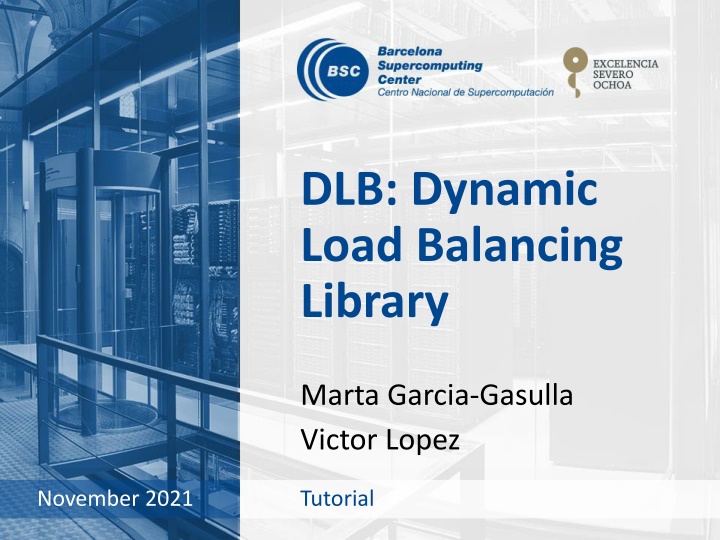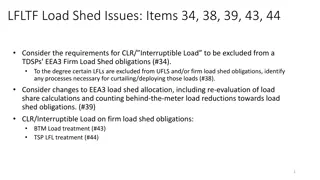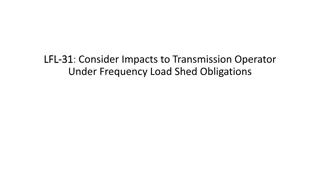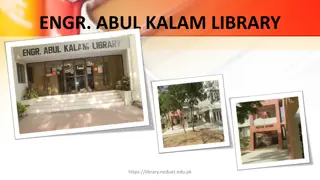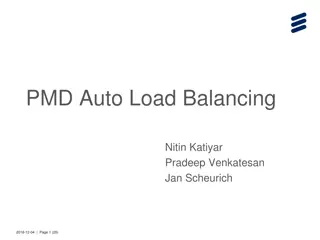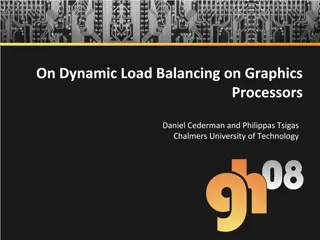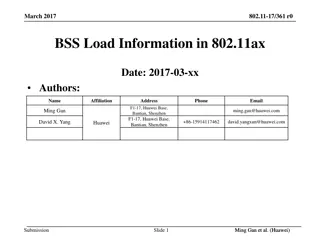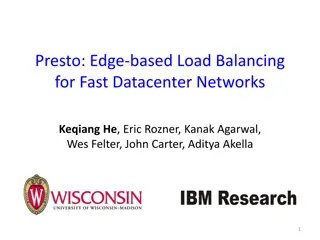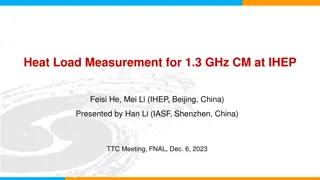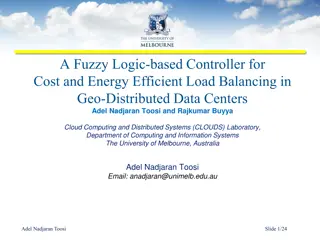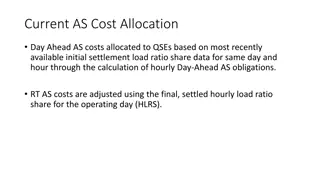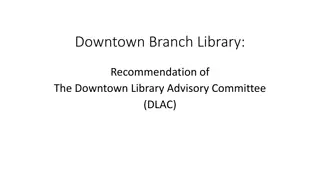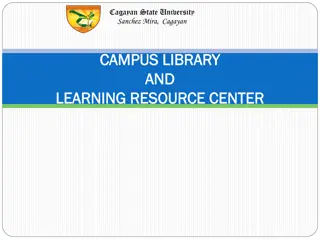Dynamic Load Balancing Library Overview
Dynamic Load Balancing Library (DLB) is a tool designed to address imbalances in computational workloads by providing fine-grain load balancing, resource management, and performance measurement modules. With an integrated yet independent structure, DLB offers APIs for user-level interactions, job scheduling, and resource management for applications using MPI, OpenMP, and OmpSs. The LeWI module allows for lending idle computational resources to speed up processes within the same node, enhancing nested parallelism. DLB's implementation includes MPI interception and support for OpenMP integration levels to optimize performance.
Download Presentation

Please find below an Image/Link to download the presentation.
The content on the website is provided AS IS for your information and personal use only. It may not be sold, licensed, or shared on other websites without obtaining consent from the author.If you encounter any issues during the download, it is possible that the publisher has removed the file from their server.
You are allowed to download the files provided on this website for personal or commercial use, subject to the condition that they are used lawfully. All files are the property of their respective owners.
The content on the website is provided AS IS for your information and personal use only. It may not be sold, licensed, or shared on other websites without obtaining consent from the author.
E N D
Presentation Transcript
DLB: Dynamic Load Balancing Library Marta Garcia-Gasulla Victor Lopez November 2021 Tutorial
Dynamic Load Balancing - DLB Our objectives: Address all sources of imbalance o Fine Grain, dynamic How? o Detect imbalance at runtime o React immediately Real product for HPC Use common programming model/environment o MPI + OpenMP Transparent to the application Runtime library
DLB structure Three modules: LeWI: For fine grain load balancing DROM: For coarse grain resource management TALP: For performance measurement Three modules, integrated but independent Common infrastructure Integration with different layers of software stack API Shared memory CPU status API App. LeWI Job Sched. MPI OpenMP PMPI Shared Mem. DROM OmpSs OS HW OMPT Process status TALP
DLB integration Integration with different layers: Application: DLB offers a user-level API Job Scheduler: DLB offers an API for resource managers MPI: PMPI interception OpenMP: OMPT interception, few OpenMP runtimes support it or API added by user OmpSs: Runtime integration with DLB library, the OmpSs runtime calls the DLB library CPU status API App. LeWI Job Sched. MPI OpenMP DLB offers mechanisms to be transparent to the application/user. DLB API is useful for advanced users that have a good knowledge of their application. PMPI Shared Mem. DROM OmpSs OS HW OMPT Process status TALP
LeWI Lend When Idle
Lend When Idle (LeWI) The idea: Use computational resources of a process when not using them to speed up another process in the same node HPC Appl. MPI 1 Shared Memory MPI 2 DLB cpu1 cpu2 cpu3 cpu4 Idle cpus Lend 2 cpus 2 4 Lend 4 cpus cpu1 cpu2 MPI call MPI call Decentralized, communication is done through shared memory LeWI a runtime balancing algorithm for nested parallelism. In Proceedings of International Conference of Parallel Processing (ICPP 2009). 7
LeWI: Implementation MPI interception: Use standard PMPI interception avoids recompiling, DLB can be used with LD_PRELOAD. Second level of parallelism: We need shared memory parallelism. Current version supports OmpSs and OpenMP. Must be malleable. Lack of malleability limits performance Malleability can be limited by the programming model or the application. OpenMP: Three levels/options of integration: API: Works with any OpenMP implementation, must modify the code and link with DLB. OMPT: Only works with OpenMP implementations implementing OMPT. Free agents: Works preloading our own version of OpenMP implementation (LLVM based) OmpSs: Fully integrated with DLB, high malleability.
LeWI: Malleability vs. Programming Model OpenMP Single parallel region OpenMP Multiple parallel regions OpenMP Free agent threads OmpSs Main OMP PARALLEL DO OMP PARALLEL OMP DO OMP PARALLEL TASK TASK TASK TASK TASK TASK Task T Can adjust threads T T TASK TASK T T TASK OMP PARALLEL DO T T OMP DO TASK TASK TASK TASK T T T TASK T TASK OMP PARALLEL DO T TASK T T TASK T TASK OMP DO TASK Number of threads can be changed
OpenMP/OmpSs Summary OpenMP OpenMP + OMPT OpenMP + free agent OmpSs CPU binding No supported Rebind through OMPT Yes Yes Malleability Only outside parallel regions Only outside parallel regions Malleability through tasking Yes Integration Add DLB_borrow before each parallel region + LD_PRELOAD LD_PRELOAD LD_PRELOAD Transparent, integrated through OmpSs
Success Story 1: ParMMG Parallel mesh adaptation of 3D volume meshes. High imbalance and changing between iterations. Pure MPI code Added OmpSs parallelization to one loop + 1 call to DLB API. 1.2x Speedup overall execution.
Success Story 2: Alya coupled codes Respiratory simulation coupling 2 codes: Fluid + particle tracking Zoom in 1 node with DLB 3 Actions: Load Balance Fluid Original Load Balance Particles With DLB Load Balance 2 codes
LeWI API int DLB_Enable(void); Enable DLB and all its features in case it was previously disabled otherwise it has no effect int DLB_Disable(void); Disable DLB actions for the calling process. int DLB_SetMaxParallelism(int max); Set the maximum number of resources to be used by the calling process. int DLB_UnsetMaxParallelism(void); Unset the maximum number of resources to be used by the calling process. int DLB_Lend( ); Lend current CPUs Int DLB_Reclaim( ); Reclaim CPUs owned by the process int DLB_AcquireCpu( ); Acquire a specific CPU, equivalent to Reclaim if the process it the owner and to Borrow if not. int DLB_Borrow( ); Borrow possible CPUs registered on DLB int DLB_Return( ); Return claimed CPUs of other processes int DLB_Barrier(void); Barrier between processes in the node These functions have 4 different versions: -void: Any CPU. -int CPU_Id: the specified CPU -int num_CPUs: the amount of CPUs indicated -CPUmask: the CPUs indicated in the mask
DROM Dynamic Resource Ownership Management
DROM: Dynamic Resource Ownership Management API for superior entity Job Scheduler Resource manager User Allow to change the owner of resources (CPUs) By the process By an external entity (Resource manager) DROM: Enabling Efficient and Effortless Malleability for Resource Managers. In Proceedings of International Conference on Parallel Processing (ICPP 2018)
DROM: Dynamic Resource Ownership Management App. MPI2 MPI1 RM cpu3 cpu4 cpu1 cpu2 DLB_DROM_Attach CPU status Shared Mem. setProcessMask DROM Process status setProcessMask cpu1
DROM: Use cases A) User: Increase priority to App2 App2 App1 App2 B) Job Scheduler: Run High priority App2 in resources assigned to App1 App1 C) App1: Release 2 CPUs because not using efficiently App1
DROM: How to A) $> dlb_taskset -p pid_app2 c 0-5 0 1 App2 2 3 4 5 App1 6 7 App2 B) $> dlb_taskset c 0,1 ./App2 App1 C) App1 DLB_DROM_SetProcessMask(my_pid, [0,0,1,1]);
DROM API int DLB_DROM_Attach(void); Attach current process to DLB system as DROM administrator int DLB_DROM_Detach(void); Detach current process from DLB system int DLB_DROM_GetNumCpus(int *ncpus); Get the number of CPUs in the node int DLB_DROM_GetPidList(int *pidlist, int *nelems, int max_len); Get the list of running processes registered in the DLB system int DLB_DROM_GetProcessMask(int pid, dlb_cpu_set_t mask, dlb_drom_flags_t flags); Get the process mask of the given PID int DLB_DROM_SetProcessMask(int pid, const_dlb_cpu_set_t mask, dlb_drom_flags_t flags); Set the process mask of the given PID int DLB_DROM_PostFinalize(int pid, dlb_drom_flags_t flags); Unregister a process from the DLB system
TALP Tracking Application Low- level Performance
TALP: Tracking Application Live Performance Profiling tool with: Low overhead Report POP metrics API to obtain metrics at runtime API to instrument code and profile regions of code Current version profiles MPI performance TALP a lightweight tool to Unveil Parallel Efficiency of Large Scale Executions. In Proceedings of Performance Engineering, Modelling, Analysis, and Visualization Strategy (Permavost 2021).
TALP App. MPI2 MPI1 cpu3 cpu4 cpu1 cpu2 MPI call Process status Compute time Process status Compute time PMPI PMPI MPI call TALP TALP API API get_metrics get_metrics MPI time MPI time MPI Finalize MPI Finalize TALP - PERMAVOST'21 - Marta Garcia-Gasulla 23
Why is more than yet another profiling tool? A profiler will report same issue while both cases have very different problems. App. A App. B MPI2 MPI1 MPI2 MPI1 MPI call cpu3 cpu4 cpu1 cpu2 cpu3 cpu4 cpu1 cpu2 MPI call MPI call MPI call MPI call MPI call MPI call MPI call MPI call MPI call MPI call MPI call MPI call TALP will report a low Load Balance for App A and a low Communication efficiency for App B MPI call MPI call MPI call TALP - PERMAVOST'21 - Marta Garcia-Gasulla 24
Using TALP At finalization At runtime # include < dlb_talp .h > DLB_ARGS=" --talp [--talp-summary=pop-metrics]" ... env LD_PRELOAD="$DLB_LIBS/libdlb_mpi.so" ./app // Register a new region or obtain an existing handler dlb_monitor_t * monitor = DLB_MonitoringRegionRegister ( Name ); // Start TALP monitoring region DLB_MonitoringRegionStart( monitor ); ... // Stop TALP monitoring region DLB_MonitoringRegionStop( monitor ); ... // Print a report by standard output DLB_MonitoringRegionReport( monitor ); ... // Manually obtain some metrics from the monitor int64_t elapsed = monitor->elapsed_time; int64_t elapsed_use =monitor->elapsed_computation_time; float comm_eff = ( float ) elapsed_use / elapsed ; TALP - PERMAVOST'21 - Marta Garcia-Gasulla 25
Success story 3: Malleable simulation Application that adjust number of resources used based on measures by TALP
About DLB Current stable version 3.0 (January 2021) LeWI DROM TALP Work in progress and future work: Free-agent implementation Extend TALP to report OpenMP metrics Integration with OmpSs@Cluster Free Download under LGPL-v3 license: https://pm.bsc.es/dlb-downloads User Guide: https://pm.bsc.es/ftp/dlb/doc/user-guide/
Looking for cooperation Applications With load issues, not only imbalances, changing loads, resources needs based on load Runtimes to integrate with DLB. Schedulers or Resource managers to integrate with DROM or TALP
Thank you marta.garcia@bsc.es victor.lopez@bsc.es https://pm.bsc.es/dlb
